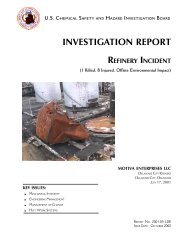CTA Report, Draft 1, ISP Review - US Chemical Safety and Hazard ...
CTA Report, Draft 1, ISP Review - US Chemical Safety and Hazard ...
CTA Report, Draft 1, ISP Review - US Chemical Safety and Hazard ...
You also want an ePaper? Increase the reach of your titles
YUMPU automatically turns print PDFs into web optimized ePapers that Google loves.
D.2 Other Pertinent NFPA Codes<br />
D.2.1 Oven <strong>Safety</strong><br />
The ignition of a dust cloud by a fire that spread from the line 405 oven is the most credible initiating<br />
event scenario (Section 7.1.1.2) for the <strong>CTA</strong> incident. NFPA 86, St<strong>and</strong>ard for Ovens <strong>and</strong> Furnaces<br />
(2003), provides guidance for preventing fire <strong>and</strong> explosion hazards associated with the heat processing<br />
of materials in ovens. The st<strong>and</strong>ard addresses fire protection; safety equipment <strong>and</strong> applications; <strong>and</strong><br />
inspection, testing, <strong>and</strong> maintenance.<br />
D.2.2 Electrical <strong>Safety</strong><br />
NFPA 499, Recommended Practice for the Classification of Combustible Dusts <strong>and</strong> of <strong>Hazard</strong>ous<br />
(Classified) Locations for Electrical Installations in <strong>Chemical</strong> Process Areas (2004), provides guidance<br />
on acceptable protection techniques for electrical equipment or systems in hazardous (classified) locations<br />
that could ignite a dust cloud or layer. This st<strong>and</strong>ard designates hazardous locations where combustible<br />
dusts are present as Class II, Divisions 1 <strong>and</strong> 2, 29 as adopted from the National Electric Code (NFPA 70).<br />
NFPA 499 recommends that electrical installations be designed <strong>and</strong> enclosed in a “dust-ignition proof” 30<br />
manner or otherwise pressurized or made intrinsically safe.<br />
D.2.3 Explosion Venting <strong>and</strong> Explosion Suppression Systems<br />
Confinement is one of the requirements for a dust explosion. (Figure 10 [Section 6.2] shows the dust<br />
explosion pentagon.) <strong>Review</strong> of the <strong>CTA</strong> facility design <strong>and</strong> assessment of facility damage indicate that<br />
the processing area had many confined areas.<br />
29<br />
In Division 1, a combustible material is likely to be present continuously or intermittently under normal<br />
conditions of operation, repair, maintenance, or leakage. In Division 2, a combustible material is likely to be<br />
present under abnormal operating conditions, such as failure of process equipment or containers.<br />
30<br />
“Dust-ignition proof” refers to enclosure that excludes dusts; such enclosure prevents arcs, sparks, or heat<br />
otherwise generated or liberated inside from igniting exterior accumulations or atmospheric suspensions of a<br />
specified dust on or in the vicinity of the enclosure.<br />
119









